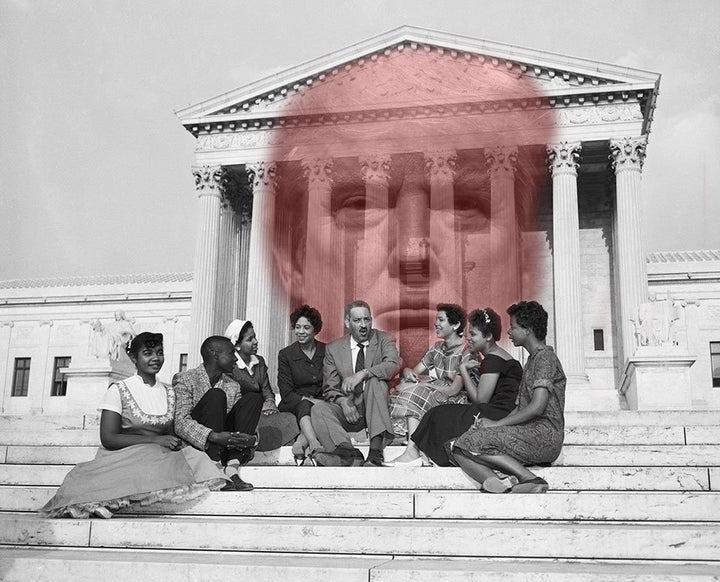
Donald Trump’s personal life ― in all likelihood ― has not been directly impacted by the patterns of public school segregation. Trump attended a private school in Queens as a child, before transferring to a private military boarding school as a teen. His four older kids attended private high schools, and his youngest is also currently enrolled at a private school in Manhattan.
But his rise to power ― as the nation’s newest president-elect ― is likely related to the dismantling of school desegregation policies, according to several researchers and academics who study school diversity.
In recent years, integration of schools has largely been abandoned as a national priority ― an indicator that various racial groups are spending less time interacting. This lack of familiarity makes it easy for students, parents and stakeholders to demonize groups who don’t look like them ― a staple of Trump’s campaign, said Gary Orfield, distinguished professor and co-director of the Civil Rights Project at UCLA.
“The American dream is very, very similar across racial and ethnic lines. People who actually experience interracial contact, especially under appropriate conditions, develop more positive attitudes,” said Orfield, who has been studying this issue for decades. “Racial segregation fosters prejudice. It fosters false understandings.”
Trump’s strategy to embolden racists with hate rhetoric ― speaking of Mexican immigrants as “rapists” and proposing a ban on Muslims entering the country ― did not become a winning one in a vacuum. In part, the dismantling of school desegregation efforts ― coupled with demographic changes that have resulted in the country being more diverse ― may have created the landscape that allowed Trump’s racially-charged agenda to thrive.
However, when people from different groups spend time together ― whether it be at a school soccer game or PTA meeting ― prejudices typically fade. Latinos ― who bore the brunt of much of Trump’s rhetoric ― are especially segregated in schools. Because of this isolation and a sustained population surge, it makes sense that Latinos have been targeted by Trump and his supporters, says Orfield. The average Latino student attends a school that is 57 percent Latino, while the average white student attends a school that is 73 percent white ― suggesting that these two populations are not often in situations where they are raising families together.
“Its been a change so dramatic and so fast, I think many whites are stunned.”
Decades of evidence on racial integration suggest that racially integrated school environments reduce racial prejudice and bias, according to Richard Kahlenberg, a senior fellow at the Century Foundation, a public policy research group.
“That’s been a major setback in this country where we’ve seen resegregation by race and class in the public schools,” Kahlenberg said. This can open the door to “scapegoat minorities.”
Trump’s election has emboldened racists so much so that in the days since Nov. 8, a rash of racial and religiously-based hate crimes have broken out around the country. Research shows that GOP voters who feel most warmly about Trump seem to have the most negative attitudes about immigrants, Islam and living in a majority-minority nation.
In schools’ demographics we see how these negative attitudes may have been borne. Between 1968 and 2011, there was a 28 percent decline in white public school enrollment, and a 495 percent increase in levels of Latino students, according to Orfield’s research. Nationwide, school populations now have a majority of minority children. Black students in regions like the south and west are now more segregated than they were in the late 80s and 90s, and schools in the northeast are more segregated than they were before 1968.
This is partly because Brown v. Board of Education ― the supreme court case that made state-sanctioned segregation unconstitutional in 1954 ― only dealt with the question of white and black students, making Latinos largely invisible in subsequent school desegregation policies.
“We just assumed we could go through this very dramatic demographic change without really working on it, from either side really,” Orfield said. “Its been a change so dramatic and so fast, I think many whites are stunned. Especially older whites, they think their society is going away. And it is. We’re creating a different society.”
But it’s not just in schools where populations can be exposed to diversity. In previous decades, the military brought together groups from different racial and economic backgrounds, Kahlenberg said. Once the draft ended in 1973, the military no longer served such a function.
Religious institutions, too, could make a difference in promoting racial tolerance, although there is little indication that this is happening, said Matthew Delmont, a professor of history at Arizona State University.
“We’re really left with public schools as the place where people of different backgrounds can come together and learn from one another,” Kahlenberg said.
The most recent election cycle has brought explicit hate back into the national discourse, Delmont said. Schools could provide a long-term solution to this by providing “more daily interactions across racial and ethnic lines,” he said. There’s opportunity for more nuanced and informed conversations to take place.
“Watching how the debates unfolded in this last presidential cycle, white Americans and people of color are talking past each other and fundamentally understand issues of race and prejudice in very different terms,” said Delmont, who wrote a book about resistance to school desegregation in the north. He said he couldn’t guarantee that racially integrated schools would change the political outlook, but it does encourage people to talk to each other.
“When you have conditions of segregation as we do in this country,” he said, “It’s easy for people to let their fears dominate how they view the world.”
______
Rebecca Klein covers the challenges faced in school discipline, school segregation and the achievement gap in K-12 education. In particular, she is drilling down into the programs and innovations that are trying to solve these problems. Tips? Email: Rebecca.Klein@huffingtonpost.com.
______
Related Stories:
